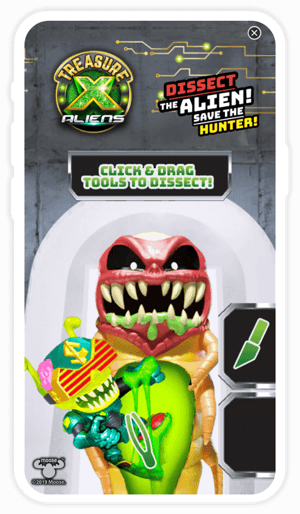6 Examples of In-Game Advertising
December 4, 2022
Editorial Policy
All of our content is generated by subject matter experts with years of ad tech experience and structured by writers and educators for ease of use and digestibility. Learn more about our rigorous interview, content production and review process here.

Key Points
- The best in-game advertising is both non-disruptive and impactful.
- Whether your in-game ads are effective often comes down to picking the right ad format for your game.
- In-game advertising formats include rewarded video ads, interstitial ads, banner ads, playable ads, full-game ads, and integrated ads.
When done right, in-game advertising can be the most effective way of monetizing your mobile, web, or desktop app game without sacrificing user experience. But there’s a lot of nuance in that “when done right.” What does effective in-game advertising really look like?
At Playwire, we’ve spent the last 15 years becoming an industry leader in cross-platform, revenue-boosting ad monetization for game publishers.
Here are some of the most prominent things we’ve learned along the way, including which key examples of in-game advertising work best.
Game Monetization Guide: Monetizing with In-Game Advertising
In-Game Advertising Basics
In-game ads represent the ultimate balancing act. They have to be seamlessly integrated into your game in a way that’s not distracting or disruptive for players. At the same time, they need to be noticeable and impact your player’s conscious attention to be effective.
How do you manage that balance?
The key is delivering in-game ads that are relevant, high-quality, and presented in the best format for your platform. But with so many options available, how do you know which ad type is best?
Let’s look at six examples of in-game advertising, including what their implementation entails and how they look in practice.
6 Examples of In-Game Advertising
Maybe you’re already familiar with many of the most common in-game advertising options available. But what do they look like in practice? We’ll start with our personal favorite here at Playwire: rewarded video ads.
Rewarded Video Ads
Rewarded video ads encourage users to watch a short video in exchange for some sort of reward, such as in-game currency, in-game items, or extra lives. This type of in-game advertising is becoming increasingly popular as it allows businesses to reach a large audience while also providing real value to players. It often puts the user in control, making them feel more empowered and receptive to advertising messages.
Although most often used in mobile games, rewarded video ads can be used in a variety of other applications as well. For example, they can be used to promote new products or features, or even to offer discounts and coupons.
Regardless of the use case, rewarded video ads provide an engaging, non-disruptive, and user-friendly way for publishers to monetize their games.
.gif?width=800&height=461&name=Rewarded_Video%20(1).gif)
Interstitial Ads
Interstitial ads are typically displayed full-screen within a game, temporarily taking over the user interface. Interstitial ads can be effective in grabbing a user's attention, but they can also be disruptive and cause users to abandon what they were originally doing out of frustration or impatience.
The key is to place interstitial ads in natural transition points that don’t make players feel as if they’re being kept from the action. An example of this may be after a player completes a level in a game. The ad may offer the user a discount on in-game purchases, or provide information about other games that the user could be interested in.
While interstitial ads can be effective in driving conversions, it’s important to use them sparingly and make sure that they are relevant to the user's interests. Otherwise, they run the risk of causing frustration and leading to app uninstalls. And nobody wants that.

Banner Ads
Banner ads are a common form of advertising that feels like it goes back to the internet’s beginnings. They can be static or animated, taking up just a portion of your in-game interface.
In web-based games, a banner ad or leaderboard might be displayed on a gaming website, inviting visitors to click through to learn more about a new release.
Banner ads, though easy to implement on a range of platforms, tend to be low-converting relative to rewarded video and other premium ad types.
Playable Ads
Playable ads are a type of advertising that allows users to interact with the ad before they decide whether or not to download the advertised product. For instance, a user might be able to play a mini-game within the ad, or experience part of the game's tutorial.
The goal of playable ads is to give users a taste of what the game has to offer, creating a level of excitement and interest that will encourage them to download and play the full game.
While playable ads are most commonly used in mobile gaming, they are also expanding into other areas, such as desktop app gaming.

-- Article Continues Below --
The Complete Game Monetization Resource Center
Full-Game Ad
Games that are built as ads are created with the primary purpose of promoting a product or service. They typically feature branded content and characters, and they may be designed to resemble classic arcade games or popular console titles.
Large enterprise companies often create games like this. One prime example of this is the McDonald's Video Game, which was created to promote the fast food restaurant's "I'm Lovin' It" campaign. The game got some serious attention for its funny portrayal of the fast food industry, and it was credited with helping to raise awareness of the McDonald's brand.
Full-game ads have to toe a fine line. While some games that are built as marketing maneuvers are met with criticism, others have been praised for their creativity and ability to engage players.
Integrated Ads
Integrated in-game ads are a type of advertising that is placed within a video game’s actual playable world. The ads are typically non-intrusive and placed in strategic locations within the game world. For example, an ad for a new release movie might be placed on a movie theater marquee within the game.
Integrated in-game ads can be effective because they are targeted at gamers already engaged in an immersive experience. This means that there is a high likelihood that the gamer will notice and remember the ad.
These ads are generally not perceived as being as intrusive as other forms of advertising, such as pop-ups or banner ads, but rather an enhancement of the gaming experience.
Choosing the Right Ad Type
So how do you select the right in-game advertising model for your game? There are three key factors to consider right out of the gate.
Game Type
The style of the game you've created will play a big role in determining which ad type will work best. While integrated in-game ads can be highly effective in first-person shooters and other action games where there are plenty of potential ad placements within the game world, they might be disruptive and distracting in puzzle games where players need to focus on the task at hand.
Banner ads and other types of display ads are more likely to be ignored in fast-paced games but can be well suited for slower-paced games where players have more time to take in their surroundings.
Consider the type of game you've created and how it will impact the effectiveness of different ad types.
Platform
Unfortunately, the capabilities of some in-game advertising software companies are limited by platform. While some may excel on mobile or web-based games, their programmatic limitations leave desktop app game developers in the cold.
In fact, Playwire’s RAMP Platform is one of the only solutions that offers the same programmatic capabilities available to mobile and web publishers, and access to the same level of demand, to desktop app publishers. Even rewarded video ads are possible in desktop app gaming through RAMP.
Audience
Ad appropriateness shouldn’t be an afterthought when creating an in-game advertising strategy. Not only can presenting irrelevant ads turn gamers away from your game but presenting ads that aren’t age-appropriate can lead to complaints and compliance issues.
Partner with an in-game advertising software company that prioritizes ad appropriateness and relevance when filling ad units. Nothing can diminish revenue faster than an inappropriate or non-compliant ad.
In-Game Advertising: Where to Start
In-game advertising is a powerful way to boost revenue by reaching players where they're already spending their time and attention. But with so many games and platforms to choose from, how do you know where to start?
The first step is finding an experienced in-game advertising software provider like Playwire. We have the technology, demand partnerships, premium ad units, and 15 years of expertise to help you navigate the in-game advertising landscape, identify the right opportunities for your brand, and deliver impactful campaigns.
Ready to make in-game advertising work for your business? Contact us today to learn more.

-1.png?width=800&height=157&name=1-playwire-logo-primary-2021%20(1)-1.png)





